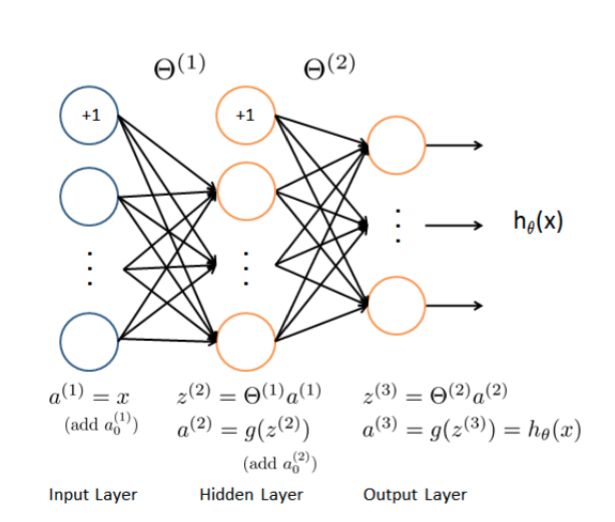吴恩达机器学习作业Python实现(三):多类分类和前馈神经网络
吴恩达机器学习系列作业目录
1 多类分类(多个logistic回归)
我们将扩展我们在练习2中写的logistic回归的实现,并将其应用于一对多的分类(不止两个类别)。
import numpy as np
import pandas as pd
import matplotlib.pyplot as plt
from scipy.io import loadmat
Dataset
首先,加载数据集。这里的数据为MATLAB的格式,所以要使用SciPy.io的loadmat函数。
def load_data(path):
data = loadmat(path)
X = data['X']
y = data['y']
return X,y
X, y = load_data('ex3data1.mat')
print(np.unique(y)) # 看下有几类标签
# [ 1 2 3 4 5 6 7 8 9 10]
X.shape, y.shape
# ((5000, 400), (5000, 1))
其中有5000个训练样本,每个样本是20*20像素的数字的灰度图像。每个像素代表一个浮点数,表示该位置的灰度强度。20×20的像素网格被展开成一个400维的向量。在我们的数据矩阵X中,每一个样本都变成了一行,这给了我们一个5000×400矩阵X,每一行都是一个手写数字图像的训练样本。

第一个任务是将我们的逻辑回归实现修改为完全向量化(即没有“for”循环)。这是因为向量化代码除了简洁外,还能够利用线性代数优化,并且通常比迭代代码快得多。
1.2 Visualizing the data
def plot_an_image(X):
"""
随机打印一个数字
"""
pick_one = np.random.randint(0, 5000)
image = X[pick_one, :]
fig, ax = plt.subplots(figsize=(1, 1))
ax.matshow(image.reshape((20, 20)), cmap='gray_r')
plt.xticks([]) # 去除刻度,美观
plt.yticks([])
plt.show()
print('this should be {}'.format(y[pick_one]))
def plot_100_image(X):
"""
随机画100个数字
"""
sample_idx = np.random.choice(np.arange(X.shape[0]), 100) # 随机选100个样本
sample_images = X[sample_idx, :] # (100,400)
fig, ax_array = plt.subplots(nrows=10, ncols=10, sharey=True, sharex=True, figsize=(8, 8))
for row in range(10):
for column in range(10):
ax_array[row, column].matshow(sample_images[10 * row + column].reshape((20, 20)),
cmap='gray_r')
plt.xticks([])
plt.yticks([])
plt.show()
1.3 Vectorizing Logistic Regression
我们将使用多个one-vs-all(一对多)logistic回归模型来构建一个多类分类器。由于有10个类,需要训练10个独立的分类器。为了提高训练效率,重要的是向量化。在本节中,我们将实现一个不使用任何for循环的向量化的logistic回归版本。
首先准备下数据。
1.3.1 Vectorizing the cost function
首先写出向量化的代价函数。回想正则化的logistic回归的代价函数是:
J ( θ ) = 1 m ∑ i = 1 m [ − y ( i ) log ( h θ ( x ( i ) ) ) − ( 1 − y ( i ) ) log ( 1 − h θ ( x ( i ) ) ) ] + λ 2 m ∑ j = 1 n θ j 2 J\left( \theta \right)=\frac{1}{m}\sum\limits_{i=1}^{m}{[-{{y}^{(i)}}\log \left( {{h}_{\theta }}\left( {{x}^{(i)}} \right) \right)-\left( 1-{{y}^{(i)}} \right)\log \left( 1-{{h}_{\theta }}\left( {{x}^{(i)}} \right) \right)]}+\frac{\lambda}{2m}\sum^n_{j=1}\theta^2_j J(θ)=m1i=1∑m[−y(i)log(hθ(x(i)))−(1−y(i))log(1−hθ(x(i)))]+2mλj=1∑nθj2
首先我们对每个样本 i i i 要计算 h θ ( x ( i ) ) h_{\theta}(x^{(i)}) hθ(x(i)), h θ ( x ( i ) ) = g ( θ T x ( i ) ) h_{\theta}(x^{(i)})=g(\theta^Tx^{(i)}) hθ(x(i))=g(θTx(i)), g ( z ) = 1 1 + e − z g(z)=\frac{1}{1+e^{-z}} g(z)=1+e−z1 sigmoid函数。
事实上我们可以对所有的样本用矩阵乘法来快速的计算。让我们如下来定义 X X X 和 θ \theta θ :

然后通过计算矩阵积 X θ X\theta Xθ ,我们可以得到:

在最后一个等式中,我们用到了一个定理,如果 a a a 和 b b b 都是向量,那么 a T b = b T a a^Tb=b^Ta aTb=bTa,这样我们就可以用一行代码计算出所有的样本。
def sigmoid(z):
return 1 / (1 + np.exp(-z))
def regularized_cost(theta, X, y, l):
"""
don't penalize theta_0
args:
X: feature matrix, (m, n+1) # 插入了x0=1
y: target vector, (m, )
l: lambda constant for regularization
"""
thetaReg = theta[1:]
first = (-y*np.log(sigmoid(X@theta))) + (y-1)*np.log(1-sigmoid(X@theta))
reg = (thetaReg@thetaReg)*l / (2*len(X))
return np.mean(first) + reg
1.3.2 Vectorizing the gradient
回顾正则化logistic回归代价函数的梯度下降法如下表示,因为不惩罚theta_0,所以分为两种情况:

所以其中的梯度表示如下:
def regularized_gradient(theta, X, y, l):
"""
don't penalize theta_0
args:
l: lambda constant
return:
a vector of gradient
"""
thetaReg = theta[1:]
first = (1 / len(X)) * X.T @ (sigmoid(X @ theta) - y)
# 这里人为插入一维0,使得对theta_0不惩罚,方便计算
reg = np.concatenate([np.array([0]), (l / len(X)) * thetaReg])
return first + reg
1.4 One-vs-all Classification
这部分我们将实现一对多分类通过训练多个正则化logistic回归分类器,每个对应数据集中K类中的一个。
对于这个任务,我们有10个可能的类,并且由于logistic回归只能一次在2个类之间进行分类,每个分类器在“类别 i”和“不是 i”之间决定。 我们将把分类器训练包含在一个函数中,该函数计算10个分类器中的每个分类器的最终权重,并将权重返回shape为(k, (n+1))数组,其中 n 是参数数量。
from scipy.optimize import minimize
def one_vs_all(X, y, l, K):
"""generalized logistic regression
args:
X: feature matrix, (m, n+1) # with incercept x0=1
y: target vector, (m, )
l: lambda constant for regularization
K: numbel of labels
return: trained parameters
"""
all_theta = np.zeros((K, X.shape[1])) # (10, 401)
for i in range(1, K+1):
theta = np.zeros(X.shape[1])
y_i = np.array([1 if label == i else 0 for label in y])
ret = minimize(fun=regularized_cost, x0=theta, args=(X, y_i, l), method='TNC',
jac=regularized_gradient, options={'disp': True})
all_theta[i-1,:] = ret.x
return all_theta
这里需要注意的几点:首先,我们为X添加了一列常数项 1 ,以计算截距项(常数项)。 其次,我们将y从类标签转换为每个分类器的二进制值(要么是类i,要么不是类i)。 最后,我们使用SciPy的较新优化API来最小化每个分类器的代价函数。 如果指定的话,API将采用目标函数,初始参数集,优化方法和jacobian(渐变)函数。 然后将优化程序找到的参数分配给参数数组。
实现向量化代码的一个更具挑战性的部分是正确地写入所有的矩阵,保证维度正确。
def predict_all(X, all_theta):
# compute the class probability for each class on each training instance
h = sigmoid(X @ all_theta.T) # 注意的这里的all_theta需要转置
# create array of the index with the maximum probability
# Returns the indices of the maximum values along an axis.
h_argmax = np.argmax(h, axis=1)
# because our array was zero-indexed we need to add one for the true label prediction
h_argmax = h_argmax + 1
return h_argmax
这里的h共5000行,10列,每行代表一个样本,每列是预测对应数字的概率。我们取概率最大对应的index加1就是我们分类器最终预测出来的类别。返回的h_argmax是一个array,包含5000个样本对应的预测值。
raw_X, raw_y = load_data('ex3data1.mat')
X = np.insert(raw_X, 0, 1, axis=1) # (5000, 401)
y = raw_y.flatten() # 这里消除了一个维度,方便后面的计算 or .reshape(-1) (5000,)
all_theta = one_vs_all(X, y, 1, 10)
all_theta # 每一行是一个分类器的一组参数
y_pred = predict_all(X, all_theta)
accuracy = np.mean(y_pred == y)
print ('accuracy = {0}%'.format(accuracy * 100))
Tips: python中 true就是1,1就是true,false就是0,0就是false
2 Neural Networks
上面使用了多类logistic回归,然而logistic回归不能形成更复杂的假设,因为它只是一个线性分类器。
接下来我们用神经网络来尝试下,神经网络可以实现非常复杂的非线性的模型。我们将利用已经训练好了的权重进行预测。

def load_weight(path):
data = loadmat(path)
return data['Theta1'], data['Theta2']
theta1, theta2 = load_weight('ex3weights.mat')
theta1.shape, theta2.shape
因此在数据加载函数中,原始数据做了转置,然而,转置的数据与给定的参数不兼容,因为这些参数是由原始数据训练的。 所以为了应用给定的参数,我需要使用原始数据(不转置)
X, y = load_data('ex3data1.mat')
y = y.flatten()
X = np.insert(X, 0, values=np.ones(X.shape[0]), axis=1) # intercept
X.shape, y.shape
a1 = X
z2 = a1 @ theta1.T
z2.shape
z2 = np.insert(z2, 0, 1, axis=1)
a2 = sigmoid(z2)
a2.shape
z3 = a2 @ theta2.T
z3.shape
a3 = sigmoid(z3)
a3.shape
y_pred = np.argmax(a3, axis=1) + 1
accuracy = np.mean(y_pred == y)
print ('accuracy = {0}%'.format(accuracy * 100)) # accuracy = 97.52%
虽然人工神经网络是非常强大的模型,但训练数据的准确性并不能完美预测实际数据,在这里很容易过拟合。

